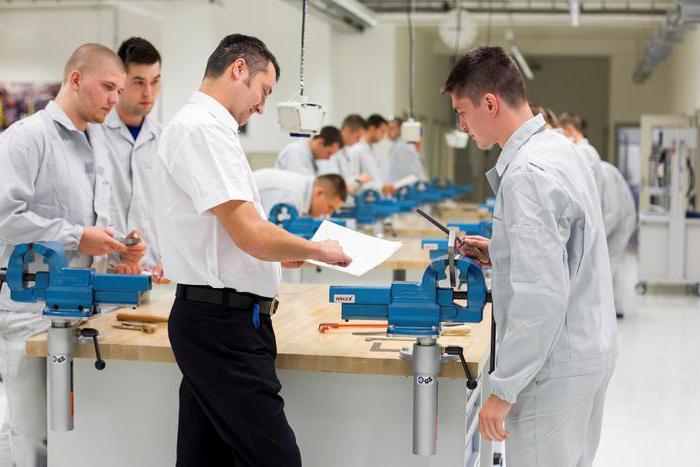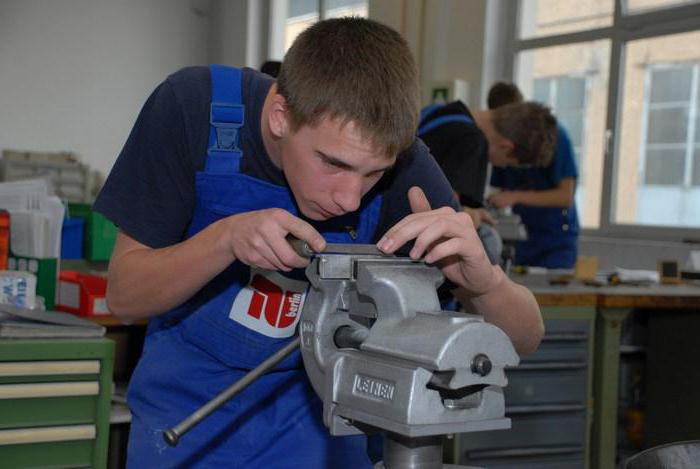The dual vocational education system is a comprehensive training model. Theoretical training is carried out in an educational institution. The practical part is organized directly at the workplace. Under such a program, enterprises send applications for a specific number of specialists. Educational institutions, in turn, draw up training programs with the participation of employers. Practice for students is organized at the enterprise without interruption from the process of obtaining theoretical knowledge.
Foreign experience
The dual education was first introduced in Germany. Her experience today is considered a model for the entire EU. Dual education in Germany includes a fairly developed institution of mentoring, characterized by the active participation of enterprises in training. This model of training has a strict legislative framework in the country. Dual education is implemented with the participation of craft and commercial chambers.
Model value
The dual education system is an excellent opportunity for the enterprise to prepare personnel taking into account the peculiarities of its activities. As part of training programs, maximum compliance with the needs of the organization is achieved. In addition, the company saves money on the search and selection of personnel, their retraining and adaptation. Dual education allows you to choose the best students. Future specialists themselves get good motivation. Upon completion of training, they will be guaranteed a job at the enterprise. It should also be noted that the introduction of dual education has a positive effect on the reputation of companies and their image on the labor market. For small companies wishing to participate in the programs, but not having the opportunity to organize their own workshops, inter-production training centers are being formed with the support of chambers of commerce.
Model Objectives
Dual education is designed to contribute to the development of independence and painless adaptation of young professionals in adulthood. Programs are designed in such a way that already during training they begin to receive rewards for their work. Dual education provides a smooth entry into the working environment, eliminates various stresses associated with a lack of experience and theoretical knowledge. The aim of the programs is not only training in the skills of performing specific duties, but also the formation of the ability to work in a team, social competence and responsibility.
Career impact
Practice for students on the job provides continuous professional growth. The level of training in the program is constantly increasing. More recently, 14-year-olds became students. Currently, quite mature young people with a solid knowledge base are increasingly appearing among them. Every sixth student has a certificate of complete education. However, many of them are in no hurry to go to college, preferring to get a profession first. This is fully justified. After all, no higher education provides such knowledge about production as dual training. This fact attaches great importance to programs in reaching career heights.
Value for the state
The government, introducing dual education, effectively solves the problem of training qualified employees. In the German economy, the burden in the field of education lies mainly with enterprises. According to statistics, companies annually spend more than 40 billion euros on staff development. This amount significantly exceeds the cost of maintaining universities. The state provides support for the training of specialists in enterprises, financing the development of vocational schools. The main function of the government is to coordinate the legislative framework.
Regulatory support
Germany has passed a law regulating vocational education, and “Handicraft Code”. These regulations regulate the interaction of youth with enterprises and educational institutions. The law defines companies that can participate in dual education. Of the 3.6 million organizations involved half a million. The provisions on training are adopted by the participants in the tariff negotiations - the structures of enterprises and employees. Their implementation is carried out at the ministerial level. The Ministry of Labor, in turn, draws up the Regulation on Training. It governs exam requirements.
Interagency collaboration
The general ideology of partnership is defined by the Federal Institute of Vocational Education. On the basis of it, the German Ministry of Education and Science interacts with other interested departments and ministries. In the federal states the Permanent Conference is working. It involves education ministers from each administrative unit. On each territory, the activities of all vocational schools are monitored, standard provisions are developed, the provision of teaching staff and the content of training programs are coordinated. The jurisdiction of land ministries also includes legal supervision and interaction with regional chambers on vocational training issues. The tasks of the latter include monitoring the availability in organizations of the necessary conditions for students, as well as the formation of examination commissions. As a result, a unified educational space is provided in the country, with the possibility of territorial units to solve their own specific tasks in the field of vocational training.

Education in Russia
In the domestic sphere of education, things are not so good. Nevertheless, continuous work is underway at the government level to improve the situation. In particular, agreements on cooperation with the regions that won the competition of the Agency for Strategic Initiatives (ASI) have already been signed. Dual education in our country is introduced in 10 subjects: Yaroslavl, Kaluga, Sverdlovsk, Ulyanovsk, Volgograd, Nizhny Novgorod and Moscow Region, in the Krasnoyarsk and Perm Territories and in the Republic of Tatarstan. The signing of the agreements was attended not only by the regions and the Agency, but also by the Ministry of Economic Development, Industrial Trade, and Labor. In addition, the parties were the Ministry of Education and Science of the Russian Federation and the Russian-German Chamber of Commerce. Agency Director D. Peskov noted that the program was supported by President V.V. Putin. In his message to the FS, the head of state focused on the introduction of training models that are effective for the formation of highly qualified production personnel. The President expressed hope that education in Russia will enter a new course. Training programs, in turn, should become generally accepted models.
Dual Education Project: Feature
The developed model involves the union of enterprises, educational institutions and regional authorities. Co-financing of training employees for specific jobs is carried out by companies that order personnel for themselves, and by bodies of entities. It is worth noting that the experience of dual education in the country has already been. However, today programs are being introduced in an unplanned economy. Enterprises that are interested in obtaining highly qualified personnel strive to solve problems voluntarily and share responsibility for the training of specialists.
Program objectives
The development and implementation of the dual education project is aimed at ensuring the modern level of professional training and retraining of personnel for the priority sectors of advanced high-tech production in the framework of public-private partnership. The main objectives of the program are:
- Development, testing and modernization of training models based on 14 centers.
- Further training of employees of engineering and pedagogical specialties involved in the training of highly qualified personnel.
- Formation of the material and technical base for vocational education organizations.
- The use of methods for forecasting personnel requirements for the medium term. As an example, the enterprises of the defense industry of the Moscow region The implementation of this task is aimed at ensuring volume planning and a training scheme for specialists at all levels of education, the formation of a state order and control reception numbers.
- Alignment of the content, structure, technologies for the implementation of educational programs, taking into account the requirements of employers, applicable standards, the forecast of the labor market and socio-economic development.
- The use of social accreditation mechanisms based on a modular competency- based approach and standards with the direct participation of employers and their associations.
- Formation of conditions for improving the system of independent analysis and assessment of the quality of education, recognition of qualifications.
- The development of training models in the workplace, including through the creation of resource centers in enterprises.
- Expansion of the terms of reference of employers in the field of vocational training management and recognition of qualifications.
- Improving the regional program of educational and methodological assistance to organizations providing vocational training, including the formation of industry centers.
- Creating the necessary conditions for the technical re-equipment of vocational education institutions.

Conclusion
A significant effect in improving the system of training qualified personnel can be obtained provided that part of the responsibility will be assumed by representatives of the business community. At the same time, a joint zone of interaction between the state, employers and educational institutions should be created. According to experts, the experience of introducing dual education abroad can be successfully applied in the Russian Federation. Current legislation allows you to implement this model, taking into account current conditions. However, undoubtedly, the experience of foreign partners will require adaptation in Russia.